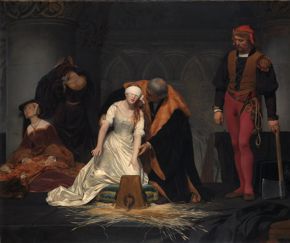Lost & Found: The Iconic Royal Painting That Rose Again October 19, 2018
Towering above visitors to the exhibition Tudors to Windsors: British Royal Portraits from Holbein to Warhol is a monumnetal painting of the execution of Lady Jane Grey, who ruled England from July 10 to July 19 in 1553—earning her the historical moniker “Nine-Days Queen.”
A History of a Painting
To keep Britain’s monarchs Protestant, Lady Jane Grey (1537–1554) was named queen at the age of 16. After a series of political machinations, Mary I—a Catholic, and King Henry VIII’s eldest daughter—took the crown, and Lady Jane Grey was executed months later. French painter Paul Delaroche interpreted the drama of this story by depicting the moment just before Jane’s death in the 1833 painting The Execution of Lady Jane Grey, which was quite a sensation when it was exhibited in the 1834 Paris Salon.
A Surprise Discovery
In the confusion of World War II, The Execution of Lady Jane Grey was misplaced and thought to have been lost for years. The painting remained missing until 1973, when a Tate Gallery curator was going through damaged carpets and found the rolled-up canvas of the Delaroche painting. It was transferred to the National Gallery, where David Bomford—then a restorer at the National Gallery, and now the chairman of conservation and Audrey Jones Beck Curator of European art at the MFAH—appraised the painting with a team of colleagues, working together to bring the painting depicting death back to life.
When the restored painting returned to gallery walls, it was immediately a sensation again and one of the most popular works of art among National Portrait Gallery visitors. Houston audiences can now discover the once-lost masterpiece for themselves.
See the painting and much more in “Tudors to Windsors: British Royal Portraits from Holbein to Warhol,” on view in the Law Building through January 27, 2019.






